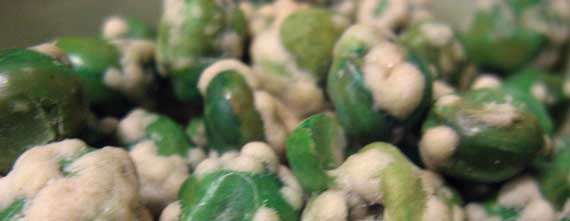Chickpea history
Thursday, 7 June 2007

Yeah, I know these are wasabi peas not chickpeas….
Most people theorizing on the origins of plant domestication—agriculture—get around to improved dietary energy sources and risk reduction sooner or later. In other words, they find 1) the calories with respect to the energy involved in production, especially of grain species were improved with domestication and formalized planting/growing, and 2) the assumed storage potential for grains and seeds means the food source is available for a longer period.
In a recent article, researchers propose that the chickpea has a somewhat different story behind it. Both its wild progenitor and domesticated versions have elevated levels of tryptophan, which increase serotonin in the brain. Increased serotonin means increased satiety, and, possibly, increases in cognitive performance, thus lowering aggression and improving social integration (yeah, I’m collapsing the argument substantially here). The enriched tryptophan diet also increases ovulation rates, and increases demographic potential. The chickpea was, as I understand it, the largest pulse in use at that time (over 10K yrs ago), so had, you might say, the most bang for the buck along these lines.
I take it as a given that long before the Neolithic revolution, our ancestors were very aware of biochemical inputs from dietary sources, so I don’t find this farfetched. Nutritional subtleties had to have been factors in domestication and the adoption of agricultural practices. That and the great fun attached to consuming fermented starchy foods…but that’s another topic….